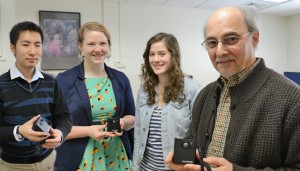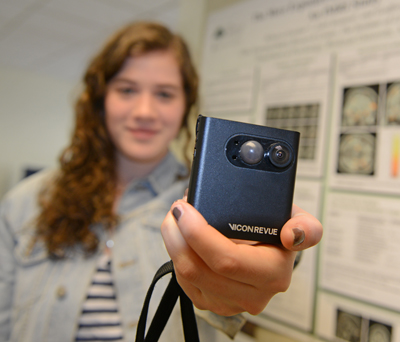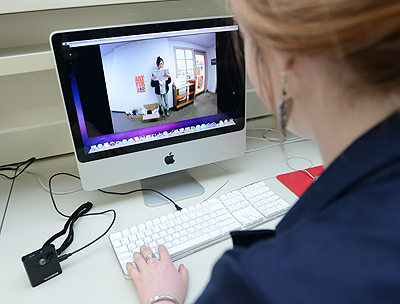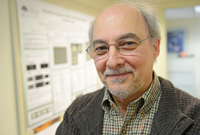Psychology Lab Studies How Cameras May Help Memory-Impaired People

For people suffering in the early stages of Alzheimer’s disease, from head injuries or other conditions that impair memory, a special trip to the seashore or a visit with family may be just a blur by the end of the day. With assistance from a simple device known as a ViconRevue memory camera, Professor John Seamon and his students are studying whether it’s possible to help these patients remember more of their lives. While the studies are ongoing, early results are promising. They also suggest that our current understanding of how these patients’ brains are malfunctioning may be wrong, or perhaps too simplistic.
Seamon, professor of psychology, professor of neuroscience and behavior, is conducting research both in his Memory Lab at Wesleyan, and at the Olin Neuropsychiatry Research Center at the Institute of Living at Hartford Hospital. The memory camera device was invented by researchers at Microsoft about 10 years ago. A small and lightweight black camera, it is worn on a lanyard around the patient’s neck, and automatically takes a photograph every 30 seconds, or whenever it senses motion or a change in light. It is hoped that reviewing these snapshots of the day’s events later will help patients remember many details that would otherwise be out of reach.
According to Seamon, a handful of case studies have been published in the last five years about memory-impaired people wearing the special camera who are taken on an outing by their spouse or adult child. When the people later reviewed pictures of the day taken by the camera and reminisced about the events with their loved ones, they showed improved recollection of the outing, which remained for a period of months.

The recollection with the memory camera is much more detailed and longer-lasting than in other cases where the memory-impaired person reviewed the day’s events with the assistance of a diary written by their loved one. Perhaps most exciting, says Seamon, is that with help from the camera, memory-impaired individuals are able to remember details from the outing not captured in the pictures.
“That’s really intriguing because it tells us that this information is getting into their minds, but part of their difficulty is getting it out,” he says. “We’ve more or less been assuming that these people have a problem producing new memories. But that may not be it, or it may just be a part of their problem. This suggests that there’s something we can work with. It may be a matter of finding the right kind of cues to help them remember.”
These case studies, while promising, have many uncontrolled variables. A year ago, Seamon set out to study the camera’s effectiveness in several experiments, using both Wesleyan students (who have no memory problems) and outpatients at the Institute of Living (who have mild memory impairments, but can still function independently) as subjects. In the first experiments conducted at Wesleyan, the experimenter took participants on a tour around campus, stopping at about 40 locations. At each location, the experimenter described an action and then performed it. The actions were atypical—hugging a water cooler, tickling a fire hydrant, begging a Pepsi machine for a soda—so the participants would not be able to automatically associate them with the location later. Afterwards, participants returned the lab and the experimenter reminisced with them about the tour. Some participants did this with no memory aid, while others were given a diary in which to take notes, and others used the memory camera. A week or two later, the participants returned to the lab and were tested on their recollection of the tour. According to Seamon, participants in all three conditions tested equally well, remembering about 75 percent of the actions performed. It seemed to make no difference whether or not they used a memory aid.

Yet the memory camera did make a difference when a simplified version of this experiment was repeated with memory-impaired patients at the Institute of Living. The patients who used the camera showed better recollection than those who used a written diary. The reminiscing and testing process was repeated several times with these subjects, and the performance gap widened with each subsequent round, suggesting that the memory cameras may help patients preserve memories for the long term.
Going forward, Seamon plans to expand the study to include many more memory-impaired subjects. He also suspects that the memory camera can be helpful in improving recollection in people with normal memory function, and hopes to find the right experiment that can demonstrate this with Wesleyan students. Other experiments he has planned for the future include testing how the memory camera improves recollection when subjects are shown short film clips, and when those with normal memory are asked to remember what they ate for dinner a week earlier (an exercise mimicking a memory impairment).
Tacie Moskowitz ’13 is one of the students in Seamon’s Memory Theory and Research seminar. She previously took Seamon’s “Human Memory” class during her sophomore year, and loved it. She also has long enjoyed photography, so when Seamon asked if she was interested in helping to conduct the memory camera research, she says, “I was excited at the chance to combine memory and photographs to see in what ways the two are connected.”
Taking Wesleyan students through the walk they designed for the research has been “a nice and silly way to meet other students on campus,” Moskowitz says. “Also, seeing how the data comes out at the end of each semester is definitely an exciting process. Even when we don’t get the results we were expecting, we always learn something new about the nature of our experiment.”
Boyuan (Julian) Zhong ’13 also led students on tours as part of the memory camera research. Though it wasn’t required for the research, he found it fascinating to observe the participants as they tried to commit the different actions to memory.
“It was really amazing to see how students tried their best to remember the actions and associate them with the specific location. Without noticing, they often used different memorization techniques. Some kept repeating the words describing the action, some tried to perform the action themselves, and some just stared at me without moving as if taking a ‘mental picture,'” Zhong recalls. “But apart from those memory techniques, it was also interesting to see how different memory aids used in the experiment clearly yielded different results.”

years at Wesleyan.
Seamon says that working at the Institute of Living has illuminated for him the struggles faced by memory-impaired patients and their families. He’s hopeful that his research with the memory cameras will ultimately help improve patients’ quality of life—not only by improving their recollection of the past, but by helping them to think about the future.
Seamon explains that as our understanding of the complexities of human memory has grown more sophisticated, it’s become clear that memory is not just a repository of information, as it was once thought of. Our brains don’t store literal copies of past experiences to be retrieved, like the snapshots from a memory camera. Instead, our memories are interpretations of these experiences.
“Because it’s reconstructive, memory allows us to take our interpretations of past experiences and combine them in novel ways to think about the future. The function of memory is to help us use what we learned in order to lead better future lives,” he says.
The memory-impaired people at the Institute of Living “all have problems remembering the past, but they also have problems thinking about the future. These two things go hand in hand. And so one of our goals is to see not only if we can help people with memory impairments, but whether we can enhance their well-being by improving the way they think about the future,” says Seamon. “That’s what’s going to be really exciting.”

